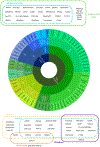A pile of pipelines: An overview of the bioinformatics software for metabarcoding data analyses
- PMID: 37548515
- PMCID: PMC10847385
- DOI: 10.1111/1755-0998.13847
A pile of pipelines: An overview of the bioinformatics software for metabarcoding data analyses
Abstract
Environmental DNA (eDNA) metabarcoding has gained growing attention as a strategy for monitoring biodiversity in ecology. However, taxa identifications produced through metabarcoding require sophisticated processing of high-throughput sequencing data from taxonomically informative DNA barcodes. Various sets of universal and taxon-specific primers have been developed, extending the usability of metabarcoding across archaea, bacteria and eukaryotes. Accordingly, a multitude of metabarcoding data analysis tools and pipelines have also been developed. Often, several developed workflows are designed to process the same amplicon sequencing data, making it somewhat puzzling to choose one among the plethora of existing pipelines. However, each pipeline has its own specific philosophy, strengths and limitations, which should be considered depending on the aims of any specific study, as well as the bioinformatics expertise of the user. In this review, we outline the input data requirements, supported operating systems and particular attributes of thirty-two amplicon processing pipelines with the goal of helping users to select a pipeline for their metabarcoding projects.
Keywords: amplicon data analysis; bioinformatics; environmental DNA; metabarcoding; pipeline; review.
© 2023 John Wiley & Sons Ltd.
Figures


References
-
- Andújar C, Creedy TJ, Arribas P, López H, Salces-Castellano A, Pérez-Delgado AJ, Vogler AP, & Emerson BC (2021). Validated removal of nuclear pseudogenes and sequencing artefacts from mitochondrial metabarcode data. Molecular Ecology Resources, 21(6), 1772–1787. 10.1111/1755-0998.13337 - DOI - PubMed
-
- Anslan S, & Tedersoo L (2015). Performance of cytochrome c oxidase subunit I (COI), ribosomal DNA Large Subunit (LSU) and Internal Transcribed Spacer 2 (ITS2) in DNA barcoding of Collembola. European Journal of Soil Biology, 69, 1–7. 10.1016/j.ejsobi.2015.04.001 - DOI
Publication types
MeSH terms
Substances
Grants and funding
LinkOut - more resources
Full Text Sources

